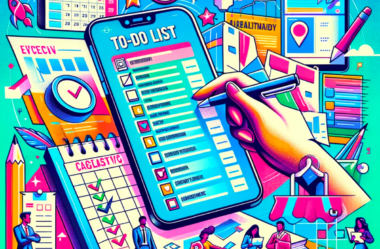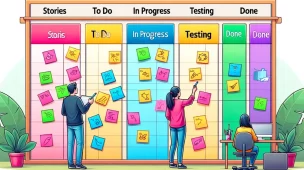Introduction
Managing tasks effectively is a universal challenge. Whether it’s for work, home, or personal goals, a well-structured to-do list can be a lifesaver.
This article provides accessible and effective To-Do List techniques for creating to-do lists that everyone can use, focusing on free tools and simple strategies to enhance daily productivity.
1. Start with a Fresh List Each Day
Begin each day with a clean slate. A new list eliminates the clutter of completed or outdated tasks, allowing you to focus on what’s relevant now. This fresh start each morning sets a clear direction for the day.
2. Categorize Your Tasks
Divide your tasks into categories like ‘Home’, ‘Work’, and ‘Personal’. This separation helps you to quickly identify and group related tasks, making your list more organized and manageable. You can use a simple notebook or free apps like Google Keep for categorization.
3. Prioritize Wisely
All tasks are not equally urgent or important. Mark tasks as ‘High’, ‘Medium’, or ‘Low’ priority. This helps you focus on what needs immediate attention, ensuring critical tasks don’t get lost in the shuffle.
4. Keep It Simple and Achievable
Overloading your to-do list can be overwhelming. Limit your list to a realistic number of tasks each day. A shorter, achievable list increases the likelihood of completion and provides a sense of accomplishment.
5. Choose Simple, Free Tools
The right tool for your to-do list doesn’t have to be expensive. Free digital tools like Microsoft To Do or a straightforward paper notebook can be equally effective. The key is to choose a tool that you’re comfortable with and that fits into your daily routine.
6. Be Specific and Clear
Vague tasks lead to procrastination. Be specific about what each task entails. For example, instead of ‘Email clients’, write ‘Email client X about project Y deadline’. This clarity makes tasks easier to start and complete.
7. Set Realistic Deadlines
Assign deadlines to keep yourself on track. Deadlines should be realistic, providing enough time to complete tasks without unnecessary stress. They act as a personal commitment to getting things done within a set timeframe.
8. Regularly Review and Update
To-do lists are dynamic. Regularly review and adjust your list to reflect changes in priorities and new tasks. This keeps your list current and ensures that no important task is overlooked.
9. Share and Collaborate When Appropriate
In a team setting or even within a family, sharing your to-do list can enhance collaboration. Use free tools like Trello for shared task management, allowing everyone involved to stay updated and contribute.
10. Find a Method That Suits You
There’s no one-size-fits-all approach to to-do lists. Experiment with different techniques and tools until you find a method that works best for you. Some may prefer digital tools for their convenience and features, while others might find traditional pen and paper more effective.
Summary of Effective To-Do List Techniques for Everyone
- Start Fresh Daily: Begin each day with a new list to maintain focus on current priorities and avoid clutter from completed or outdated tasks.
- Categorize Tasks: Organize your to-do list into categories such as ‘Work’, ‘Home’, and ‘Personal’ for better organization and focus.
- Prioritize Tasks: Clearly mark tasks based on their urgency as ‘High’, ‘Medium’, or ‘Low’ priority to ensure important tasks are addressed first.
- Keep It Manageable: Limit the to-do list to a realistic number of tasks to avoid feeling overwhelmed and increase the likelihood of completion.
- Use Simple, Free Tools: Opt for straightforward and free tools like Microsoft To Do or Google Keep, or traditional pen and paper, according to your preference.
- Be Specific: Make each task clear and specific to avoid ambiguity and make starting and completing tasks easier.
- Set Deadlines: Assign realistic deadlines to tasks to create a sense of urgency and aid in effective time management.
- Regularly Update: Keep the to-do list dynamic by regularly reviewing and updating it to reflect new priorities and changes.
- Share and Collaborate: In collaborative settings, share your to-do list to enhance teamwork and ensure everyone is aligned with their responsibilities.
- Personalize Your Approach: Experiment with different methods and tools to find a to-do list system that resonates with your personal style and enhances productivity.
Conclusion
To-do lists aren’t just about remembering tasks; they’re about taking charge of your time and your life.
With these tips, you can turn your list into a powerful tool that helps you stay organized, focused, and on top of your game.
Remember, the best list is the one that you’ll use and that works for you. So, go on, give these ideas a whirl and see how they transform your day-to-day hustle!
Other Resources About Productivity Books:
Books
- “Getting Things Done: The Art of Stress-Free Productivity” by David Allen: This book introduces the GTD method, a popular productivity system that helps you organize and prioritize tasks effectively.”Deep Work: Rules for Focused Success in a Distracted World” by Cal Newport: Newport explores the benefits of deep, concentrated work and provides strategies to minimize distractions.
- “The 7 Habits of Highly Effective People” by Stephen R. Covey: A classic in the productivity and personal development genre, this book offers a principle-centered approach for solving personal and professional problems.
Websites and Blogs:
- Lifehacker (lifehacker.com): A website offering tips, tricks, and downloads for getting things done more efficiently.
- Zen Habits (zenhabits.net) by Leo Babauta: A blog focusing on finding simplicity and mindfulness in daily life, including productivity and organization.
- The Productivityist (productivityist.com) by Mike Vardy: This blog provides insights and tools to help you define your day, funnel your focus, and make every moment matter.
Podcasts:
- “The Tim Ferriss Show”: Tim Ferriss, the author of “The 4-Hour Workweek,” interviews world-class performers to extract tactics, tools, and routines listeners can use.
- “Beyond the To-Do List”: This podcast features interviews with people who have implemented productivity strategies in their professional and personal lives.
- RescueTime: An app that tracks how you spend your time on your digital devices, offering insights into your daily habits and productivity.
“The Productivity Show” by Asian Efficiency: Tips and strategies to increase productivity, improve time management, and develop positive habits.
Apps and Tools:
- Trello: A visual project management tool that uses boards, lists, and cards to organize and prioritize projects.Evernote: A note-taking app that helps you capture and prioritize ideas, projects, and to-do lists, ensuring nothing falls through the cracks.
Online Courses:
- “Productivity Masterclass: Create a Custom System That Works” on Skillshare: Taught by YouTuber and productivity expert Thomas Frank, this course helps you build a productivity system that fits your life.
- “Getting Things Done” on LinkedIn Learning: A course based on David Allen’s productivity method, focusing on organizing tasks, managing time, and maintaining focus.
“Become a SpeedDemon: Productivity Tricks to Have More Time” on Udemy: This course offers techniques and tools to boost productivity, including automating and outsourcing tasks.
Articles:
How To Create A To-Do List: Tips And Techniques For Effective Planning
FAQs
What is the best way to start a to-do list?
The best way to start a to-do list is with a fresh approach each day. Begin by listing out tasks that are most relevant for the current day, eliminating any clutter from previous days.
How can I effectively categorize tasks on my to-do list?
Categorize tasks based on their areas, such as ‘Work’, ‘Home’, or ‘Personal’. This helps in organizing your tasks and focusing on similar items together. Using simple categorization methods or free tools like Google Keep can make this process easier.
Why is prioritizing tasks important?
Prioritizing tasks helps you focus on what’s most urgent and important, ensuring that critical tasks get your immediate attention and are less likely to be overlooked.
Can a to-do list be too long?
Yes, a to-do list can be overwhelming if it’s too long. It’s more effective to have a shorter list that’s realistic and achievable, which increases the likelihood of completing tasks and reduces stress.
What are some free tools for to-do lists?
Some popular free tools for to-do lists include Microsoft To Do, Google Keep, and Trello. These tools offer a range of features and can be accessed on various devices.
How specific should tasks on a to-do list be?
Tasks should be specific and clear to avoid ambiguity. Instead of general tasks, break them down into specific actions you need to take, which makes them easier to start and complete.
What’s the importance of setting deadlines in a to-do list?
Deadlines help to create a sense of urgency and keep you on track. Setting realistic deadlines for each task helps manage your time effectively and ensures timely completion.
How often should I review and update my to-do list?
Regularly reviewing and updating your to-do list is crucial. This can be done daily or weekly, depending on your schedule and the nature of your tasks, to keep your list current and relevant.
Is sharing a to-do list beneficial?
Sharing a to-do list can be beneficial, especially in collaborative environments like work or family settings. It helps in distributing tasks and ensures everyone is aligned and aware of their responsibilities.
How do I find the right to-do list method for me?
Finding the right method involves experimenting with different techniques and tools. Try various approaches, be it digital or traditional, and stick with the one that feels most natural and enhances your productivity.












